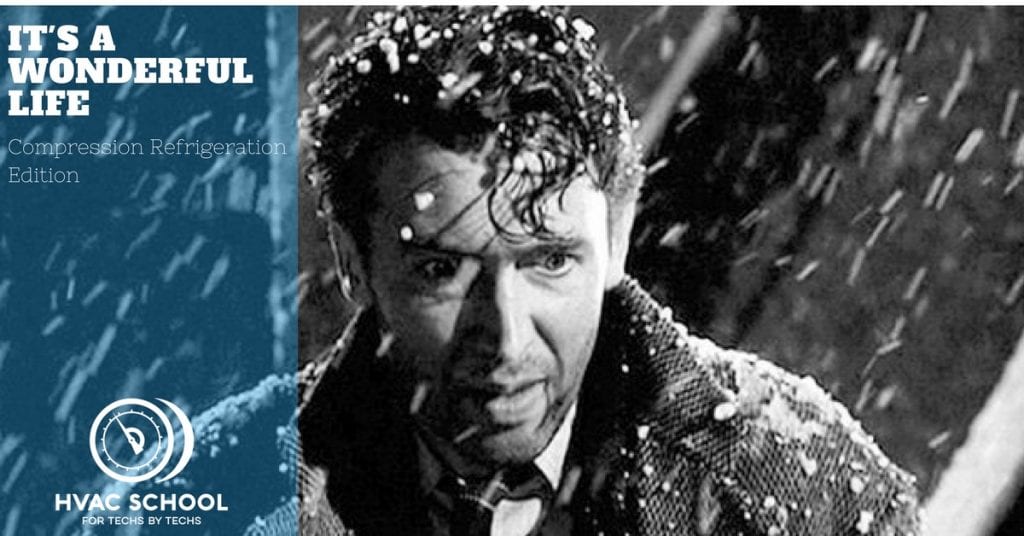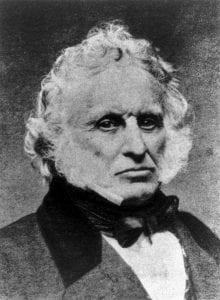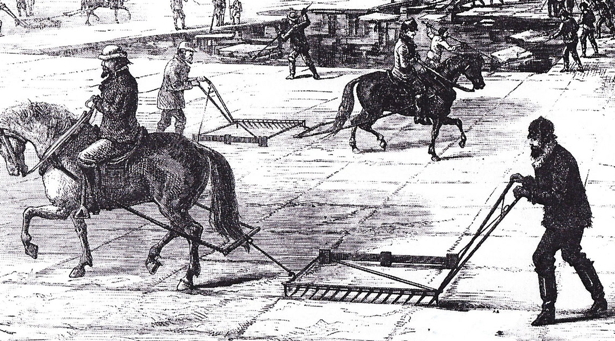Get Tech Tips
Subscribe to free tech tips.
It’s a Wonderful Life (Compression Refrigeration Edition)

Every year. We watch it EVERY YEAR, and it still gets to me again and again. Call me a sucker, but especially living a blue-collar life working in the trades, It's a Wonderful Life describes the way many of us live. Even more so, it captures the way we can start to feel about our lives and our life's work. Now, if you HAVE NEVER watched It's a Wonderful Life, don't read this until you do; it won't make sense.
We work day in and day out, for people and with people who don't always notice what we do or see the value in it (or so we think). The truth is, as the movie reveals, that we all matter more than we think. What we do, and to even a greater extent WHO WE ARE, has an enormous impact on others and the world around us.
But this story isn't about you or me; this story is about compression refrigeration and what it did to transform the world.

Remember Mr. Potter from the movie? Take a good look at the man above. Those fluffy white mutton chops belong to Frederic Tudor, and this grouchy-looking man is the “Mr. Potter” of our tale…
But let's not get ahead of ourselves.
The year was 1806, and Frederic Tudor returned from a trip to the Caribbean with the idea that exporting ice from the lakes and ponds of Massachusetts would be his path to fortune. He was right but not immediately.
The Ice failure
Now, Frederic Tudor (from here on referred to as Fred) DID NOT invent the idea of using ice to cool food and drinks. As long as humans have roamed the earth, they have been using ice for one thing or another. What Fred did was create a commercial ice TRADE, and at first, he was REALLY bad at it. Fred's first few shipments of ice from Massachusetts to the Caribbean island of Martinique ended in failure, not only because much of the 80 tons of ice had melted away but also because the locals saw no need for Fred's frozen water. Most of the ice, like Fred's dreams of profit, just melted away.
In fact, between the years of 1809 and 1813, Fred racked up some major debts he couldn't pay. These debts landed him in prison THREE TIMES. It was Massachusetts, after all, and they didn't shy away from burning witches, throwing tea into Boston harbor, or sending debtors to prison. Fred was no exception to this rule, and not unlike Bill Belichick in his days with the Jets. He may have been cast off for a time, but Boston loves a winner, and Fred was a winner.
The Ice King Cometh

Fred's story continues after the war of 1812 had settled down…
You know the war of 1812, right? The one that was just a big misunderstanding where the British burned the Whitehouse to the ground? Well, that war had an impact on the newly created international trade for ice. By 1815, everything had calmed a bit, and Fred learned that in order to sell ice, he had to:
- Become a pitchman for the product. Sure, prevention of meat spoilage was the most important market for his product, but serving ice cold drinks in the summer was the sizzle that sold the frozen steaks.
- Cut the ice more efficiently. Cutting by hand was labor-intensive. Fred figured out how to cut and move the ice with horse-drawn sleds, and it saved a TON of time. Now, the horses added some FIBER to the ice occasionally, but it was just a small consequence of progress.
- Insulate Better. After losing so much ice shipping it great distances, Fred learned how to pack the ice better and insulate more effectively.
- Diversify. Fred began shipping ice to a tropical location, saving some of the ice, and shipping back fruit preserved in ice. THAT was a genius move.
All of these gains added up, and by 1833, Fred was known as the “Ice King” when he shipped 180 tons of ice from Boston to Kolkata, India. The British elites in that far-off place were able to cool their drinks and their tempers. We didn't want another accidental White House incident, after all.
But Fred was worried. Sure, he dominated the natural ice trade, but there was a new technology that kept him up at night…
The Machines of Cold
All the way back to the 1750s (before Fred was born), inventors had been experimenting with the effects of evaporation of certain substances on the removal of heat. I can only imagine one of these men, sitting in Philadelphia in the hot Summer of 1776, thinking about how his earlier experiments might cool Liberty Hall or at least cool their drinks as they hammered out a new country. Benjamin Franklin was one of the first to consider and experiment with changing the state of liquid to vapor to produce ice, but he certainly wasn't the last.
It was inventor Oliver Evans who, in 1805, talked about a method of continuous vapor compression to make ice produced by machines a reality. However, he didn't actually make it a reality himself. After all, making a few cubes of ice with a machine would be a novelty, a parlor trick in those days. Ice needed a market, a distribution system, and a market DEMAND. Fred was the one who created those things more than two decades after Oliver's bright idea.
The Idealist

John Gorrie was not an inventor, and it's unlikely that he studied the papers of Benjamin Franklin or Oliver Evans. John was a doctor, born in the West Indies, raised in South Carolina, and educated in a prestigious New York medical school in a time when medicine was a respected profession filled with misinformation and HORRIBLE practices. That was a time when writing a constipated patient a prescription for toxic mercury or soothing a colicky infant with narcotic “soothing syrup” was commonplace. So, when John moved to steamy Apalachicola, Florida, in 1833 at age 30, heaven only knows what sort of crazy nonsense he was doing to his patients unintentionally.
But…
John Gorrie was a good man by all accounts who really cared about helping people get well. He had left a comfortable life to deal with tropical diseases like malaria and yellow fever, brought into the Florida port town by sailors and spread by mosquitoes. John must have had to adjust to the oppressive heat and humidity of a Florida summer, and it was this HEAT that caught John's attention.
By this time, John had tasted some of Fred's incredible ice in a drink, and it sure made him feel better on a hot day. What if some of these illnesses could be helped—even cured—if he could control the temperature in the rooms of his patients with ICE?
His first experiments used Fred's expensive imported ice, and it sure appeared to help lift the spirits of those in his care. However, he just couldn't get enough of the stuff to make a difference. John's theory was that diseases like malaria were a “vapor” carried in from the swamps; you could reduce or eliminate the disease by draining swamps and cooling, dehumidifying, and ventilating patients' rooms.
So, like most people who have a problem they want to solve, he began reading and experimenting. In 1844, John wrote about a machine he wanted to create that consisted of
“two double-acting force pumps, one for condensing, and the other for rarifying air and an air magazine or receptacle for condensed air. It may be placed in any part of a house or ship…”
Just to save you from looking it up, rarify means to “make less dense,” or more simply to expand. In essence, John described a very simple vapor compression system that uses air as the refrigerant.
An Icy Reception
It was the summer of 1847, as the story goes, and a French nobleman Monsieur Rosan was celebrating Bastille Day in steamy Apalachicola. As the guests were commenting on the oppressive heat, the nobleman rose and announced to his guests that they would be able to enjoy chilled wine, thanks to ice mechanically produced by doctor Gorrie and his prototype machine.

In 1851, John was granted a patent for his ice-making machine. As the story goes, he also found a deep-pocketed investor willing to put up the money to make this prototype a commercial success. This person was a Boston investor lost to history, a Boston investor who died before the deal was final.
It was then that the wheels of John's ideas began to come off. In publications across the country, the articles would write of Dr. Gorrie and his folly, how inefficient his machines were, and how foolish the invention was. After all, the “Ice King” had already solved the problem by making ice available all across the globe.
Did Fred cause this trouble to fall upon John? Probably not. Did he help the process along the way? I would be willing to bet he did.
In the end, John and his friends would speak of how he was undermined by the ice lobby, by Fred, and Fred's ice gathering and shipping industry. In 1855, at the age of 51, Dr. Gorrie died a broken man—a man who, in his own words, had “had been found in advance of the wants of the country.” In other words, he accepted that he was a man before his time.
This story has no happy ending. There was no Clarence, the wingless angel, to show John the present that would have been without him or, more appropriately, the future that was. Partially because of John and his contributions, that future includes the industry that all of us HVAC/R technicians work in every day.
Conclusion
Real change within industries and societies requires someone gritty and determined to take up the cause and push the idea to its destination. Inventors like Edison and Bell, industrialists like Rockefeller and Ford, and even military leaders throughout history from Alexander the Great to Napoleon.
These people are applauded in retrospect for their brilliance and foresight, but to a man, their greatest asset was their determination. For every one of these “greats” whose names you know, there are thousands—no, millions—more who have lived simple lives, working hard towards ideas they care about. People of determination who like John Gorrie and George Bailey, do the thing they were set on the earth to do.
In the story of Mr. Potter and George Bailey or Frederic Tudor and John Gorrie, we clearly paint a hero and a villain. One man is motivated by ego and greed, the other by altruism and vision. The fact is that every person has a bit of both in us. We all want to make a living, provide for our family, and maybe buy a boat or a new truck along the way. It's a noble thing to live a simple life and put some money away to enjoy, but don't miss the opportunity to do the big thing that gets put in your path once or twice in a lifetime as well.
The fact remains that, like John Gorrie, we all play a part in the long, winding, and noble story of our trade. You and I are a link in a chain back to Gorrie, Tudor, and Franklin. To the people and systems we serve, we are more important than those men, dead and gone.
I leave you with a fitting (if a bit dramatic) poem written for Gorrie 50 years after his death.
Give him a niche in the temple of Fame
Give him his place and hallow his name!
He, who in love for his suffering kind,
Lent them the use of his wonderful mind:
Pointed the way by unheard of device
To make in the Tropics the purest of Ice.
Give him a niche! May his name never die!
Build him a monument stately and high;
Who, in the ages, has equaled his thought?
Who for his fellows such solace has brought?
Think of the troubles his skill has allayed!
Think of the inroads on pain he has made.
Give him a niche and enshrine it with flowers!
Honor the man with divinity’s powers!
He who, no matter how sultry the day,
Drove from damp foreheads the fever away:
Pay quick a tribute that nobody shuns,
To GORRIE — greatest of Florida’s sons
Now, go move some heat, and Merry Christmas.
—Bryan











Comments
Excellent historical account woven together with a classic movie – sure made it live for me! thanks Bryan.
Excellent historical account woven together with a classic movie – sure made it live for me! thanks Bryan.
To leave a comment, you need to log in.
Log In